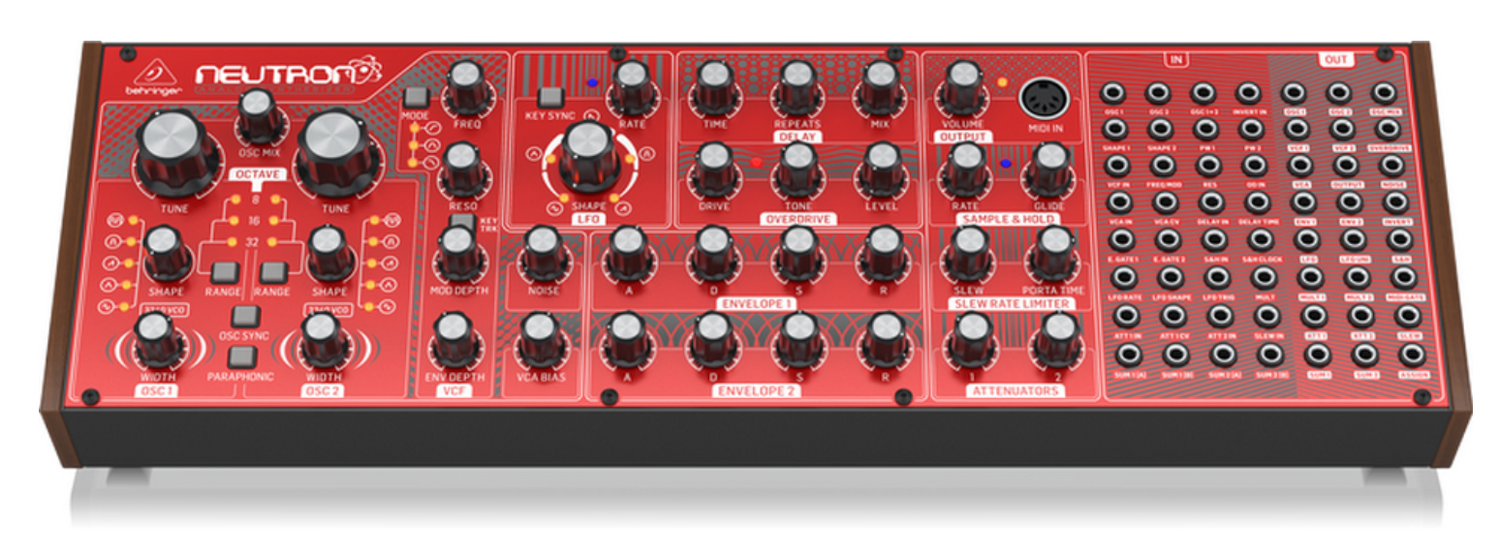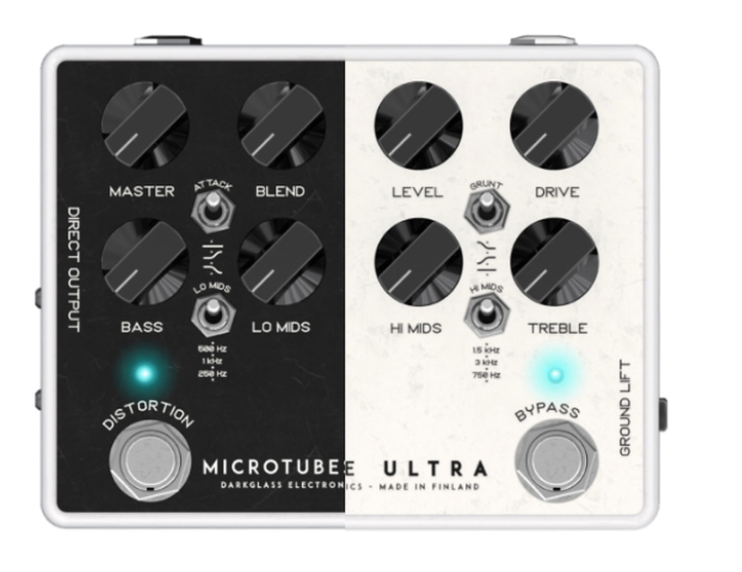The Behringer Neutron is a Semi-Modular Analog Synthesizer with a ton of capability. It features two VCO's, a VCF, and LFO, 1 amp EG and 1 VCF EG, analog delay and distortion effects, and a gigantic patch bay to integrate into your modular setup (Eurorack) - all for only $299. The Neutron packs a lot of potential into a very cheap price, especially for an all analog synth. Behringer has been doing an excellent job lately with their synths (Model D, DeepMind12, and new announced instruments), and this is no exception.

Behringer is a company that in the past has had somewhat of a bad reputation for selling cheap gear. However recently they have been releasing some incredible analog synthesizers that are cheap in price, but not in quality or features. In particular i'm talking about the Behringer Model D and the Deepmind12D, both of which I own and love. The Neutron continues this journey of Behringer's into the domain of world class synthesizers at a fraction of the cost of competitors.
Behringer Neutron Features
The Behringer Neutron is jam packed with features for such a cheap analog synth. Here is a list of them:
-
Dual 3340 analog oscillators - Paraphonic - 5 Waveforms (tone mod, pulse, sawtooth, triangle, and sine) - Originally used in OBX, Jupiter6, Prophet5 and more
-
Pure analog signal path
-
Semi-Modular architecture
-
Individual pulse width / tone mod, and tuning for each VCO
-
Self oscillation mult-mode VCF with dual output
-
2 analog ADSR generators for VCF and VCA
-
Multi-Stage analog delay
-
LFO with 5 waveforms - MIDI clock sync - key sync
-
Noise generator
-
Overdrive circuit
-
36 controls and 7 buttons
-
Utility functions for attenuation, multiples, and slew
-
32 inputs and 24 output jacks in the patch bay (YES)
-
Audio-Rate sample and hold with glide
-
1/4 Input, Output, and Headphone jacks
-
MIDI In and MIDI Thru jacks
-
USB/MIDI implementation
I made a video giving my first impressions and an overview of the Neutron. In it I show the various segments of the synth (its laid out in a pretty logical way), and talk about each knob briefly. Along the way I make some sounds to show off what most of the knobs do. Check it out below:
If you watched the video I hope you're impressed with what this thing can do. Near the end I glossed over the patch bay since I haven't had a chance to play around with it, but i'll update this post when I get the chance. The patch bay is pretty large for a semi-modular synth, and it opens up a TON more doors in terms of what the Neutron can do so don't ignore it. Even if you aren't into modular gear now, playing around with patching on the Neutron might inspire you to get into it.
For a demonstration of the sounds without me babbling away, look further down the page for my 'Exploring The Sounds' video where I just play with the Neutron for 14 minutes straight without talking.
What the heck is a Paraphonic Synthesizer?
This confused me at first too, but its actually very simple. A monophonic synth is one that can only play a single note. A duophonic synth is one that can play two notes at a time. A polyphonic synth is one that can play greater than 2 at the same time. Finally a paraphonic synth is one that can play... several notes at the same time. Maybe its not so simple. Let me clarify.
Paraphonic synths are almost identical to monophonic synths but different in one key way. In a monophonic synth you may have 3 VCO's (like the Behringer Model D), but the pitch of the oscillators is all referenced off of the same point: you can tune them differently, or let one sit at a constant note, but you can't individually change them. In a paraphonic synth you can independently control the pitches of both (or all) oscillators. How is this different than duophonic or polyphonic synths I hear you ask? Well in a polyphonic synth each note can go through the signal path and trigger its own events, such as the ADSR envelope on the VCA. In a paraphonic synth the notes are coupled so that they share all the same trigger elements.
In a nutshell, you can control the oscillator pitch independently but the notes share the rest of the synth architecture.
The Neutron Sound
Sure, it has a lot of features. But how does the damn thing sound?! Well it sounds great, but I think you saw that coming. Its an all analog synth with all the features listed above, surely it was going to sound great (unless Behringer seriously screwed something up). Just like any analog synth worth its salt (with at least 2 VCO's) you can slightly detune one of the oscillators for a super fat sound. The VCF is nice and steep, and it resonates beautifully without spinning out of control (unless you decide you want it to spin out of control). There truly is nothing like getting a slightly detuned pair of VCO square waves, putting a nice slow VCF and VCA envelope on them, and running them through a delay.
Speaking of delay, the delay on this thing is amazing! Its design is that of a BBD (Bucket Brigade Device). Its completely analog so moving the delay rate while playing will cause some incredible slow-down and speed-up effects. Setting the feedback (or repeats) to near maximum levels and cranking up the mix will allow you to spin the rate dial for some truly out of this world sounds (similar to the Befaco Crush Delay). Lets take a listen to my first 14 minutes playing with the Neutron:
The only thing that I wish the Neutron had is a polyphonic version. The Deepmind12D showed us what Behringer is capable of when they go all-out on an analog synth: 12 voices, tons of modulation, TONS of effects, advanced USB control, and much more. The Neutron would make an incredible polyphonic analog synth due to its character. There is just something about it that says 'Hey, i'm a new thing. I may be very similar to an old thing, but if you give me a chance I know you'll never forget me". Jokes aside, maybe they could have added several LFO's or even more effects, but for $299 you're really already getting a fantastic deal.
Eurorack
The Behringer Neutron isn't just a desktop analog synth. It comes with a Eurorack plug and patch cables so you can literally just take it out of its box and plop it into your rack (just like the Moog Mother-32 and DFAM, and the Behringer Model D). I love this feature because it means I don't need to have another box sitting around on a shelf, taking up space. Months ago I bought a 7' tall server rack to stuff a lot of my gear, so instead of having 2 Eurorack cases and a bunch of desktop cases I now have 1 Eurorack case and almost infinite storage for rack mount gear (we'll see how long the 'infinite' storage actually lasts).
No matter how much this feature matters to you, its a plus. If you use Eurorack cases you probably won't want to rack mount this because it will take up about 80 HP, but if you have a giant rig then it makes sense to put it with the rest of your gear. I wish it just came with 19" rack ears so I didn't have to buy another TipTop Audio Happy Ending rail / ears kit, but its not too much of an expense (plus I have several 3D printers and a masters in mechanical engineering, so maybe i'll just design some printed brackets for it).
As I mentioned in the feature list there are 32 input and 24 output patch points for patch cables. While the Neutron is pre-wired internally, you can re-route the synth using the patch matrix (this is what makes it semi-modular). I won't go into every single patch point, but there are essentially patch points for anything you could ever want to do with the Neutron (its like the number of patch points in the Moog DFAM and Mother-32 combined). You can do things like control the pitch of each oscillator separately, use the ADSR to control the LFO or delay time, or sync the instrument to your Mother-32 and DFAM. I'm sure someone will find patch points that Behringer left out, but most people will find they put in more than you'll ever use.
Behringer Neutron Review
I've only had the Neutron synthesizer for less than 1 day now (even though I pre-ordered it over 5 months ago), so I don't want to give a final score yet. I'll update this post after i've had some more experience with the Neutron, and have used it in recordings. But my first impressions are a solid 5/5 stars. You simply can not find an analog synthesizer on the market with all of these features for such a cheap price, never mind one that sounds this great.
Check back in the coming days and weeks for more videos and discussion about the Behringer Neutron. I see myself having a lot of fun with this. In the meantime, check out this great video showing 7 patches with the Behringer Neutron:



